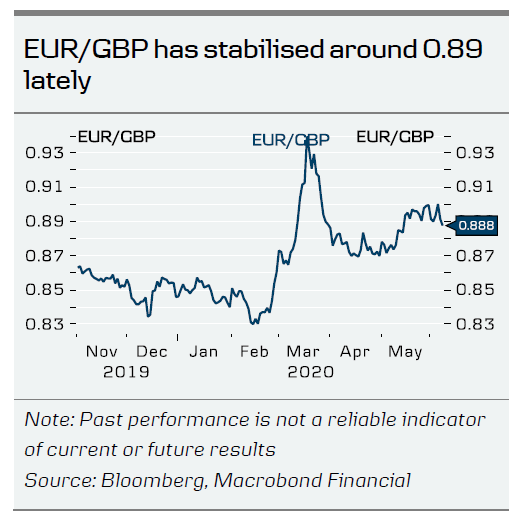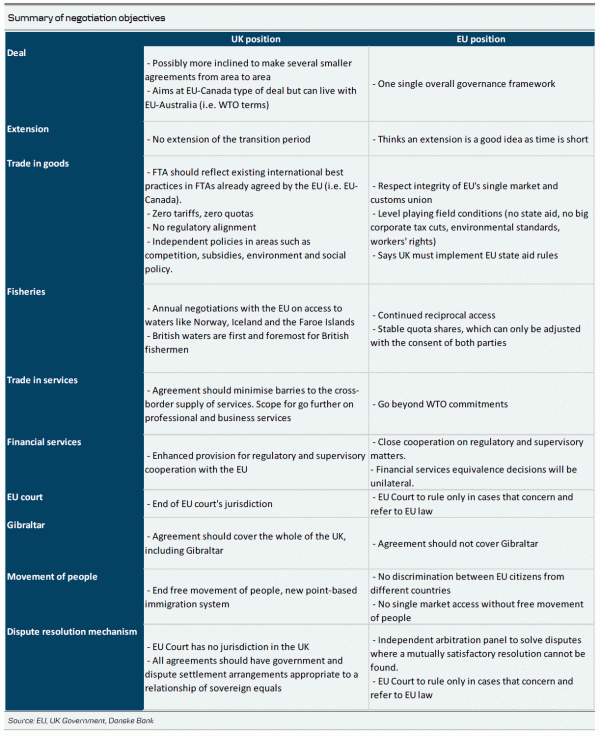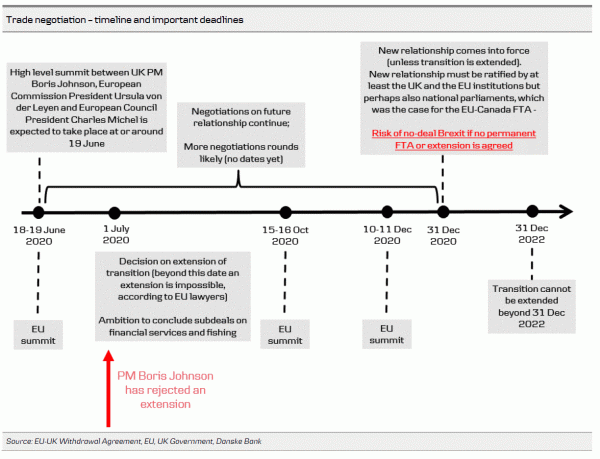Key takeaways
- As expected, the fourth and final negotiation round concluded on Friday without any major breakthrough.
- The next key event to watch out for is the high level summit between PM Boris Johnson, European Commission President Ursula von der Leyen and European Council President Charles Michel at or around 19 June.
- We do not expect the UK to ask for an extension of the transition period (deadline 1 July) and do not expect any sub-deals on fishery and financial services either.
- Our base case remains the two sides can reach a simple free trade agreement on goods trading before 31 December 2020 (65% probability), but the risk of a no deal Brexit has risen to 35% (20% previously).
- We expect EUR/GBP to move higher near-term, as investors start to reprice the risk premium. Risk to this outlook is global risk sentiment, which continues to improve. For more see page 2.
No major breakthrough at any of the four negotiation rounds
It has been a while since we sent out our latest Brexit monitor. The main reason is that not much has happened on Brexit in recent months, especially because both the EU and the UK have been occupied handling COVID-19. The current status right now is that the fourth and final negotiation round concluded on Friday 5 June and, as expected, without any major breakthrough.
The next key event to watch out for is the high level summit between the UK Prime Minister Boris Johnson, European Commission President Ursula von der Leyen and European Council President Charles Michel. We do not have a date yet, but some reports says it may be at or around 19 June, see POLITICO. Remember the deadlock in the withdrawal negotiation did not break until PM Boris Johnson met with other European leaders. The difference from then to now is that PM Boris Johnson now enjoys an 80 seat majority in the House of Commons, i.e. he can basically decide whatever he wants.
The possibility of extending the transition period expires on 1 July and despite good economic reasons for giving more time to negotiate the permanent relationship (in particular now that both the UK and the EU are in recession), we do not expect the UK to ask for an extension (10% probability of an extension). EU lawyers have said that it is not possible to extend the transition period after this date, see Institute for Government. According to the political declaration, the two sides also aim to strike sub-deals on fishery and financial services before 1 July, which, however, should be thought of as a “soft” nonbinding deadline. That said, we do not expect a deal on financial services and fishery before 1 July either (20% probability of a deal on fishery and financial services).
The biggest problem is that the two sides’ main redlines are incompatible. The UK wants to break free from EU laws and regulations and does not want to be under the jurisdiction of the EU court. EU argues that proximity and levels of trade require the UK to remain close to EU rules (i.e. what EU calls for “level playing field condition”), because the EU fears giving British companies an unfair advantage if the UK decides to significantly cut taxes, give state aid or cut environmental standards. For that reason, the EU says it cannot offer the same deal as the CETA free trade deal with Canada. Also, the EU accuses the UK of demanding more than what is included in CETA; in particular on services (e.g. recognising professional qualifications). We have collected some of the different views in the table on page 3.
Base case: Simple free trade agreement but risk of no deal Brexit has risen
Our base case (65%) remains the two sides can reach a simple free trade agreement on goods trading (not services) before year-end, possibly including some elements, which rhymes on “extension”. We believe the negotiation will follow more or less the same pattern as the withdrawal negotiation, where a deal was not found until very close to the deadline. We think this is only natural in political negotiations, where you don’t want to compromise too early, because it looks “bad” or “weak” domestically. It is easier to “sell” a political compromise closer to the deadline. The two sides still aim at concluding the negotiations no later than in October to make time for the ratification process, both in the EU and the UK. The ratification process is not as easy as with the withdrawal agreement, as the deal may lie outside of EU competences, i.e. need approval from national parliaments.
We assign a 35% probability of a no deal Brexit by year-end. This would imply the UK and the EU will trade on WTO terms from 1 January 2021. There is a high probability of an economic shock to EU-UK trade, but we recognise that it is difficult for both sides to climb down in order to reach a compromise. PM Boris Johnson has previously said that he would rather walk away from the negotiations and trade on WTO terms than sign a deal where the UK becomes a rule-taker and falls under the jurisdiction of the EU court, see The Guardian.
While some argue that COVID-19 means a lower probability of a no deal Brexit, we actually think the probability has risen, as both the UK and the EU are occupied by more urgent things. We estimated the probability at 20% back in February, see Brexit Monitor: Withdrawal done, now moving to the real Brexit talks, 4 February. The not negligible probability of a no deal Brexit also means that companies, in our view, should continue to prepare for the worst.
EUR/GBP: Repricing of Brexit risk premium to send the cross higher
We are still of the view that a repricing of the Brexit risk premium will send EUR/GBP higher, mirroring similar events in late 2018 and summer 2019. While we target EUR/GBP at 0.90 in 1-3M, we would not be surprised to see the cross move as high as 0.92. Key risks to this call are a trade deal landing more smoothly than we envisage, an extension and/or global risk sentiment continuing to improve on the back of reopenings backed by past extensive policy stimulus.
If we are right about the two sides reaching an agreement eventually, we think the cross will move lower again to something like 0.86 in 6-12M.
For more details see FX Strategy: Repricing of Brexit premium near-term, 27 May.
















